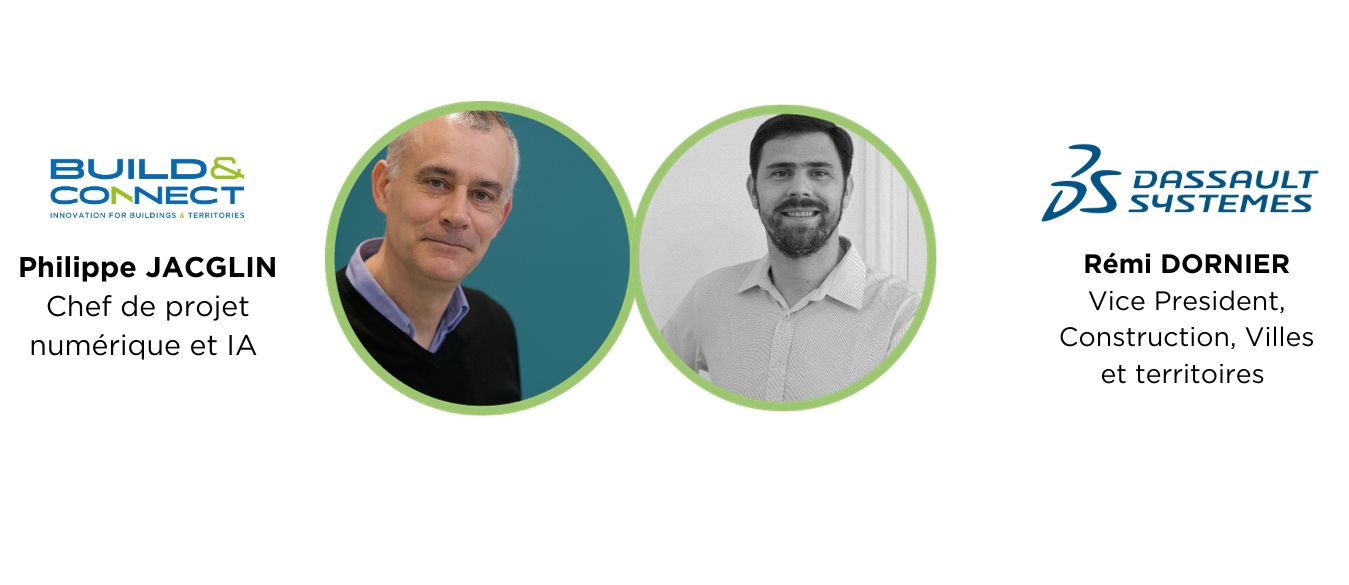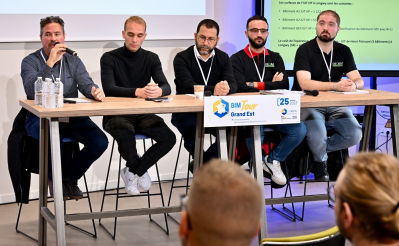News

L'Institut du Digital dans la Construction: interview with Rémi Dornier (Dassault Systèmes) and Philippe Jacglin (Build & Connect)
On the occasion of the launch of the Institut du Digital dans la Construction, Rémi Dornier (Dassault Systèmes and referent for the Pôle Build & Connect's digital and competitiveness commission) and Philippe Jacglin (digital project manager at Pôle Build & Connect) look back at the origins of this Institute. They explore the synergies between Pôle Build & Connect and the Institute, while sharing their common vision of digital transformation in the construction industry. Find out how these experts plan to meet the challenges and catalyze change in this constantly evolving field.
1/ Could you introduce Dassault Systèmes and its contribution to the construction industry?
RD : Dassault Systèmes is a scientific company that puts art, technology and science at the service of innovation. We are a world leader in sustainable innovation, offering virtual experience platforms to invent products that meet today's major challenges. That's why we're involved in industrial transformation, working alongside industry leaders and startups alike.
The breadth of the fields in which we operate (city, infrastructure, industry and healthcare) enables us to take a cross-disciplinary view and create cross-fertilization between business sectors. In this respect, we are a digital player involved in construction, for the entire value chain, from the user to the manufacturers of building equipment, via architects with software such as HomeByMe, Catia, Delmia, Enovia or Solidworks, but also thanks to strategic partnerships with leading players in the construction industry.
As far as I'm concerned, I've been with Dassaults Systèmes for over 15 years, and since 2013 I've been in charge of construction. Today, I'm in charge of this industry, one of the 12 that the Group leads.
2/ You're a member of the cluster's Board of Directors, and you're also responsible for the Digital and Competitiveness strategic axis. What links do you make between these two terms?
RD: The construction sector is in need of transformation because it is under strong pressure on 3 fronts: sustainable development, which is disrupting practices; productivity, which has not increased at the same pace as other industries; and the shortage of manpower, which is calling into question multi-trade approaches. When we talk about transformation, we're not talking about replacing local expertise, but rather about compensating for a certain number of tasks that could be more versatile.
I believe that the construction industry faces a major challenge, which is to invent the industrialization of customization, rather than mass standardization. The sector can draw inspiration from industrialization, but it has to chart its own course. This means we have to deal with the characteristics of our ecosystem: fragmented, local, very open. Digital technology can make a huge contribution, notably through the cloud, which can help to link an open ecosystem to very small businesses, which make up the fabric of players unable to implement digital revolutions on their own. Another upheaval is the generative approach and AI. In construction, you can't configure like you would a car; you have to generate from the architect's sketch and adapt. On the other hand, generative techniques can virtualize know-how, i.e. standardize and reproduce proven construction methods. Finally, the digital twin offers real gains in terms of anticipation and site organization. I'm convinced that all these digital trends can bring real competitive gains.
I think the digital revolution is upon us. The fact that we don't have much of a digital heritage in construction is an advantage, because we can move fast.
PJA : The transformation of the construction industry means moving towards a more industrial mode of production, which integrates many dimensions: we often evoke, and rightly so, off-site and modular construction, but we must also consider the notions of efficiency, lean, and changes in methods. The key is to seek flexibility in production methods, using tools such as logistics centers, ephemeral factories and off-site production, all of which need to be coordinated.
RD: Yes, off-site construction is an approach that requires substantial investment and a product line structuring approach. You need to be clear about the type of product and the work unit you want to produce. This is part of the solution, but there are also intermediate stages and a path to integrate, and ephemeral factories, logistics and kiting centers are also to be considered. The digital twin makes it possible to choose production methods based on local assets.
3/ On October 11, the Build & Connect cluster is launching the Institut National du Digital dans la Construction. What is the purpose of this Institute?
RD: To bring about innovation, you need to bring together people who would never otherwise meet. The Institute's vocation is to bring together pioneers who want to make things happen, investors capable of supporting them, and players who want to accelerate their digital development. Our aim is to create an ecosystem of sharing and exchange, so that we can move towards transformation.
Secondly, it has a national vocation. I'm convinced that France has a major trump card to play in construction. With 472,000 companies, 3 of the 10 European leaders who are also world champions, we can make France a center of excellence in construction.
PJA: This is a traditional sector, and the environmental stakes are immense. We need to move fast on issues such as decarbonization and renovation, and to do that, we need to massify the use of tools, but also develop manufacturing processes and skills. The Institute will be a catalyst for these changes. We need to work with the most motivated pioneers to get the ball rolling. The Institute is attached to the Build & Connect cluster; it will benefit from the cluster's expertise in innovation. It will be the cluster's digital arm, and should boost the number of digital research projects.
RD : Everyone is invited to take part: local authorities, architects, property developers, general contractors, manufacturers, subcontractors and craftsmen. We've structured the project around 3 pillars: "Inspiring", i.e. explaining and referencing what's being done via concrete feedback, "Training" to better appropriate these techniques and tools, and "Incubating", or enabling innovative projects to see the light of day and helping to set up structures to implement them.
We'll proceed in stages. First, we need to identify the initiatives and inspirations that make sense. This year will be devoted to framing and identifying work themes. Once this stage has been completed, we will develop and enrich the other pillars to move from inspiration to action. We are planning training courses and demonstrators, as well as research theses and chairs.
5/ Can you tell us more about the October 11th event?
RD : The aim is to inspire and meet! We'll be talking to a wide range of players, from local authorities to small pioneering companies and large groups, all of whom are already involved in the process. There will also be enlightening sessions on emerging digital concepts in construction.
PJA: There will be many innovative topics, not yet seen elsewhere. For example, a presentation by an SME that integrates automotive concepts into off-site and modular construction, and has gone a long way in the social and environmental aspects, or a feedback presentation on the management of a city in a totally new way, thanks to digital technology. Renovation will also be on the agenda.
The aim of the post-midday workshop is to find a precise framework and topics, and to identify motivated players. The aim is to set priorities and list constraints and opportunities. We hope to be able to identify concrete projects that can be launched in the short term, and provide initial feedback within 6 months.
6/ Why is the Build & Connect cluster the right place to launch this institute?
RD : This is the only national competitiveness cluster dedicated to buildings. Its aim is to spread throughout the country. We've seen that innovation is a crucial issue. Innovation needs to be supported or carried out in collaboration. The cluster provides a framework, expertise and resources to facilitate innovation.
On the other hand, faced with the challenges ahead, we need structures that bring people together. Build & Connect brings together researchers, trainers and companies, as well as local authorities, manufacturers, construction companies and project owners. That's what's needed to put projects into practice.
The Institut du Digital dans la Construction will initiate experimental projects, capitalize on feedback and monitor innovative projects.
We strongly encourage you to join our first event, which will bring together industry experts, researchers, professionals and project owners to discuss current and future trends in digital construction.
Join us for a day of exploration, discovery and reflection on the digital future of the construction industry. We hope to see many of you at this exceptional event!
Program and registration: https: //www.buildandconnect.eu/fr/event/lancement-de-linstitut-du-digital-dans-la-construction














No comment
Log in to post comment. Log in.